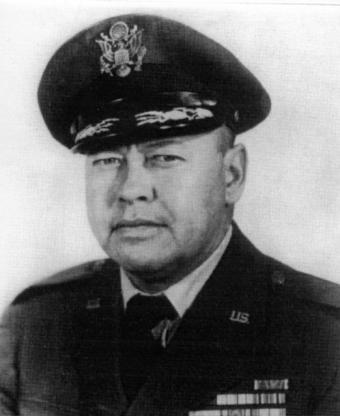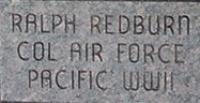Military Veterans

Ralph Albert Redburn
Date of Birth
Date of Death
Brick Location
Panel Number

Biography
Ralph’s Story about December 7, 1941, from The Arizona Republic, December 7, 1985.
“We’re Being Attacked”
Retired Officer Recalls Bad Day at Pearl Harbor
By Richard Charnock, Arizona Republic Staff
Forty-four years ago today, Ralph A. Redburn and his wife, Polly, witnessed America’s entry into World War II.
Redburn, now of Scottsdale, was then a 34-year-old Army Air Forces Captain and base engineer. He was the officer of the day at Hickam Field in Hawaii when the first bombs were dropped in the Japanese sneak attack on Pearl Harbor at 7:55 a.m., Sunday, December 7, 1941.
The attack began what has to be one of the longest days of their lives, one that Franklin Delano Roosevelt characterized to Congress the next day as “a date which will live in infamy.”
Before that day ended, Redburn was shot at, blown up and wounded, put in a hospital—which he sneaked out of—and won a medal for inventing a wooden tire.
His wife and daughter were evacuated from their apartment on the base to a half-built house in the country where they lived in two rooms with 14 other women and children for 10 days.
“I was mad all the way through,” Polly Redburn recalled this week.
Ralph Redburn said, “I thought, ‘How in hell come didn’t Washington, D.C. tell us about it? Surely they had had some kind of idea.’”
When he was transferred to Hickam six months earlier, he said, the Army wouldn’t let him bring his family. His wife and daughter had to book passage to Hawaii as tourists.
On December 7, expecting the imminent arrival of a new, yet-to-be-armed B-17 bombers from the mainland, Ralph Redburn was in the couple’s apartment, where his wife was preparing a breakfast of bacon and eggs.
“All at once, I heard what I thought were our new bombers coming in, and I said to my wife, ‘Let’s step out on the patio and watch them land,’” recalled Redburn, now a retired Air Force Colonel.
“They were off in the air about a good half-mile away. I couldn’t really see any markings on them. It was a flight of single-engine dive bombers coming from across the town of Honolulu, heading right toward Pearl Harbor.
“I thought they were Navy planes. I knew they were not any of our Army…airplanes because our planes were not allowed to fly over there on weekends. We didn’t have enough gasoline, so they were restricted.
“We’re looking at this, and all at once, I saw a bomb released, saw it falling down beneath it (the dive bomber), and I turned to my wife and said, ‘Surely that must be a dummy, because they’re dropping it on themselves.’
“I thought it was the Navy. It hadn’t quite got to the harbor yet. It was flying right toward it. So I think Mrs. Redburn and I saw the first bomb released over Pearl Harbor before it ever hit a damn thing.
“Boy, that bomb was no dummy. A great explosion took place, fire and smoke everywhere, and again I thought to myself, ‘Boy, somebody’s really going to get court martialed for fouling up like that.’”
While the Redburns were watching the dive bombers moving toward the harbor, a torpedo bomber flew right over the apartment complex at an altitude of about 50 feet, Redburn said.
“I could see on the wing of the airplane that big red ball (rising sun insignia) of theirs. I could see in there were Japanese pilots in uniform, and I turned to my wife and I said, ‘Those are Japs. The Japs are attacking us. In fact, they’re shooting at you and me.’
“So we ran back into the apartment. We had a baby girl who was 7 months old at the time. She was awake and crying because of all this noise, and Mrs. Redburn went into the bedroom and got her and they went out in the living room and I rolled our big sofa out from the wall and they crawled behind it.
• • • • •
“Remember, I’m on duty that day and I’m already in uniform,” Redburn continued. “So I ran out in the middle of our big apartment complex. . .and I’m standing out there and screaming at all of those other families, ‘Wake up, wake up! We’re being attacked, we’re being attacked!’”
As soon as the dive bombers dropped their bombs and the heavier planes their torpedoes, Redburn said, they flew back over the base and began strafing, “shooting at any old damn thing out in front of them!’”
“Bullets were just flying everywhere. After I’d run out there and started hollering for all those other couples to wake up…another officer raised his window from a second-story bedroom, stuck his head out there and said, ‘Redburn, why don’t you shut up? You’re making a hell of a lot of noise out there’
“Well, I said, ‘It’s not me. It’s the Japs. We’re being attacked.’ Then quick, I went back in the apartment and got out all my battle gear.”
Redburn headed for the operations tower. Bombs were falling, bullets zipping everywhere.
One of his sergeants set up machine guns and the Army began shooting back at the Japanese planes, hitting some of them.
• • • • •
Then came a lull in the Japanese attack.
Redburn went to a barracks housing about 2,000 men. While standing near a kitchen loading dock, he looked up and saw a second wave of bombers flying over.
“A great salvo of bombs dropped, and over 200 men were killed. One bomb landed 50 feet away from me. Lucky for me it buried itself in the ground 10 to 15 feet. It blew me up in the air.
“Something hit me on the head—I still have the scar there. I wasn’t hurt severely.”
But he was bleeding and growing dizzy from the loss of blood. So he went to the emergency room at the base hospital for treatment. A doctor gave him a tetanus shot and a nurse painted a big red Mercurochrome “T” on his forehead so “needle happy doctors” would know not to give him another shot.
A nurse did her best to hospitalize him, twice taking him to a third-floor room. But he wanted out of the place—fearing it would be the target of Japanese bombs. He finally slipped down a fire escape and made it back to the operations tower.
• • • • •
And that’s when he invented the wooden tire.
Shrapnel from bombs and artillery shells covered the runways of the air base, and planes could not take off or land because the debris pierced and flattened their tires. Redburn couldn’t sweep the field clear because the sweeper also had rubber tires that kept going flat.
So Redburn went to the woodworking shop, where he had several wooden boards bolted together. Then he and some other men drew an outline of the sweeper’s tire on them and cut them out with a band saw.
It worked, and he cleared the field. And the Army so liked his invention that it duplicated the wooden tires for use at other airfields, and a year later, awarded Redburn the Legion of Merit.
-30-
Biographical Information:
Ralph was the son of Willis and Stella Redburn of El Dorado, KS. (Willis and Stella had come to Kansas from Illinois in 1908 by train and spent the remainder of their lives in El Dorado.)
On 7 November 1936, Ralph married Pauline Beatrice Mulvaney of El Dorado. The wedding took place in San Antonio, TX. They had two daughters and one son: Pamela Sue, Joan Kathleen, and Timothy Kent.
Ralph was born in Pleasant Plains, IL, and died in Scottsdale.
Branch:
Rank
Colonel
Years
World War II and after
Duty
World War II—Pacific Theater
Ralph was present on December 7, 1941, when the Japanese bombed Pearl Harbor.
(See biographical account this page).
He later (1952 - 1960) served as Commander of the Williams Air Force Base in Phoenix, AZ

